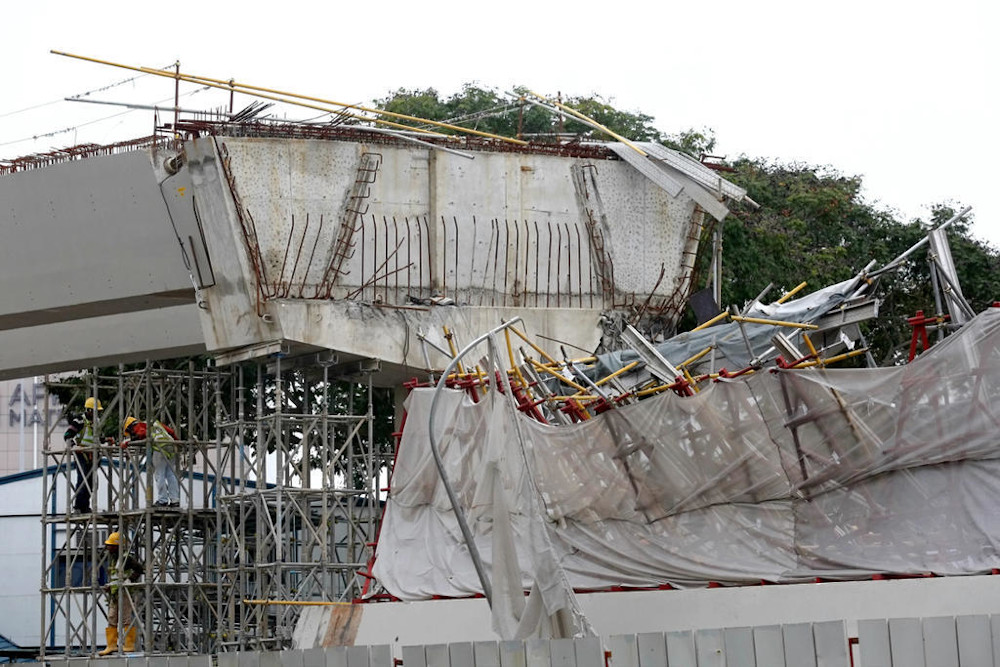SINGAPORE, Jan 22 — The main contractor involved in the 2017 collapse of an uncompleted Pan-Island Expressway (PIE) viaduct at Upper Changi Road East, as well as two of its senior employees, were found guilty today of various safety lapses leading to the fatal incident.
Or Kim Peow (OKP) Contractors was convicted of failing to ensure the safety of 11 foreign workers that were performing casting of the deck slab.
On July 14, 2017, two of the temporary concrete structures — called corbels — supporting the longest section of the viaduct gave way.
The high-profile collapse resulted in the death of 31-year-old Chinese national Chen Yinchuan who was working on the deck slab. The 10 other workers suffered varying degrees of injuries, including spinal and pelvis fractures.
OKP’s project director Yee Chee Keong, 51, and its project engineer Wong Kiew Hai, 32, were convicted today of one charge each of recklessly endangering the workers’ safety.
They had failed to stop all works, despite other personnel urging them to do so, when Wong discovered cracks on the temporary corbels supporting the deck slab some 40 minutes before the collapse.
They were also found guilty of a second charge of obstructing justice by deleting a WhatsApp conversation between them on the night of the collapse. The conversation contained photographs that Wong took of the cracks and sent to Yee.
Senior District Judge Ong Hian Sun will hear submissions on mitigation ahead of sentencing on a later date.
For their Workplace Safety and Health Act charge, Wong and Yee could be jailed for up to two years or fined up to S$200,000 (RM609,600), or both. OKP could be fined up to S$1 million for its second conviction of causing someone’s death.
For obstruction of justice, Wong and Yee could be jailed for up to seven years or fined, or both.
Cracks appeared almost a month earlier
Prosecutors charged that OKP, Yee and Wong should have foreseen — and did in fact foresee — that their workers’ safety would be compromised.
The viaduct, which is about 1.8km long and made up of 50 spans divided into eight flyovers, links the PIE to Tampines Expressway and Upper Changi Road East.
The fatal incident happened along the longest span, which measured about 43.5m long.
Numerous red flags had popped up in the lead-up to the collapse. On June 16, 2017, a month before the incident, OKP’s employees discovered cracks on one of the corbels that eventually collapsed.
OKP’s project manager, Andy Chang, took photographs of the cracks and sent them to Yee.
OKP then took steps to rectify the problem on the recommendations of OKP’s technical director, Yueng Chun Keung, but did not tell the project’s qualified person, Robert Arianto Tjandra, about this.
Tjandra was an employee of CPG Consultants, which was engaged by OKP and the Land Transport Authority to design and supervise the building works.
Two weeks later on June 30, 2017, more cracks appeared on the sides of several temporary corbels in neighbouring sections. The deck slab had already been cast to three-quarters of its length.
OKP and Tjandra discussed the cracks and took steps to reduce the load placed on the corbels.
Tjandra further instructed OKP to add two to three times more reinforcement to other corbels. This should have indicated a systemic corbel under-design problem, prosecutors said.OKP also did not tell LTA about any of the corbel cracks.
In the early hours of July 14, 2017, OKP began the works, with Wong among those present. At about 2.50am, they saw cracks on the sides of the two corbels, prompting Wong to call Yee and send him photographs.
Prosecutors said that the cracks were “much more serious” than those that appeared earlier. They were longer, wide enough to be visible from the ground more than 4m away under night lighting, and had rendered supports at both ends of the viaduct span vulnerable.
An LTA site supervisor, among others, urged Wong to stop the works. He did not.
Shortly after the collapse at 3.30am, Wong and Yee deleted their WhatsApp conversation. They argued that they did this in a moment of panic.
Both men also lied to the authorities that they had ordered for works to stop but could not implement this in time.
Senior Judge Ong noted that they deleted the conversation, which would have contradicted their lies, out of a “self-serving motive” and in a “calculated manner”.
“Even if they were labouring under any fear or panic, it was more likely that they would be implicated in the collapse if the authorities found out the truth,” the judge added.
As for OKP, prosecutors said that the firm was content to rely on others to ensure their workers’ safety, repeatedly claiming it was not their responsibility or that they did not know.
Others dealt with
Just before the 60-day trial began in August 2019, OKP was fined S$10,000 for other safety lapses over the collapse.
The firm pleaded guilty to carrying out unauthorised strengthening works to a permanent corbel of the structure on July 8, 2017. A second similar charge, for failing to get approval for the strengthening works, was taken into consideration for sentencing.
All three charges against its group managing director, Or Toh Wat, 52, were withdrawn after he was given a conditional warning.
One charge against Yee — for permitting the carrying out of said strengthening works — was also withdrawn.
Tjandra, 47, was sentenced to about one year and nine-and-a-half months’ jail in December 2019. The design engineer pleaded guilty midway through the trial to failing to double-check his team’s calculations.
The project’s accredited checker, engineering consultancy boss Leong Sow Hon, 62, was jailed for six months after pleading guilty to failing to check detailed structural plans and design calculations of the viaduct in accordance with regulations.
The High Court dismissed his appeal against his sentence late last year. — TODAY






















